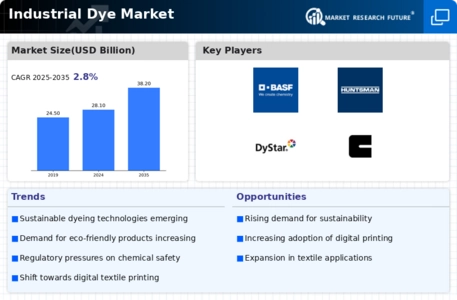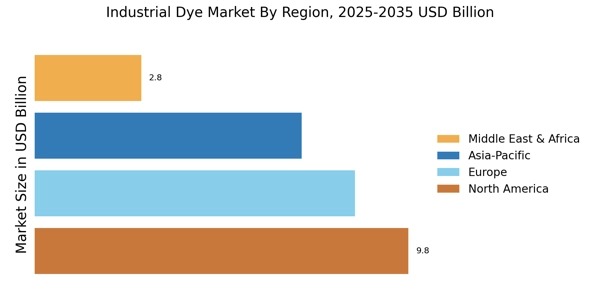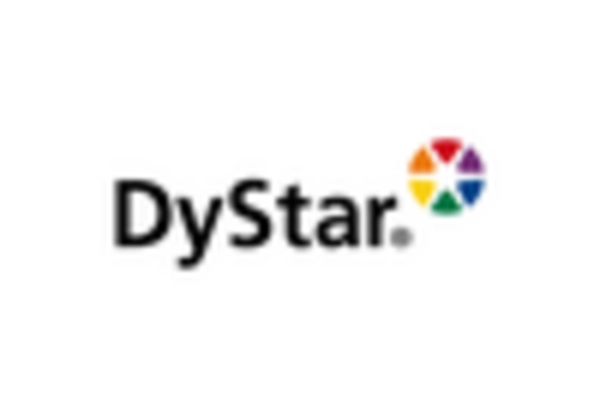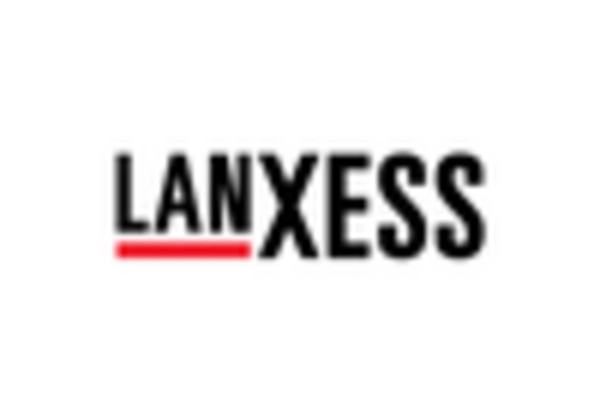Growth in Automotive Sector
The automotive sector is increasingly becoming a significant driver for the Industrial Dye Market. With the rise in vehicle production and the demand for aesthetic enhancements, the need for high-quality dyes is on the rise. In 2025, it is estimated that the automotive industry will contribute around 15% to the overall dye consumption. This growth is attributed to the trend of customizations and the use of dyes in various components, including interiors and exteriors. Manufacturers are likely to focus on developing dyes that offer durability and resistance to fading, which could further propel the Industrial Dye Market. Additionally, the shift towards electric vehicles may introduce new opportunities for specialized dyes, potentially reshaping market dynamics.
Expansion of Emerging Markets
Emerging markets are becoming increasingly vital to the growth of the Industrial Dye Market. As economies develop, there is a rising demand for dyed products across various sectors, including textiles, automotive, and consumer goods. In 2025, it is projected that these markets will account for a substantial share of the overall dye consumption, driven by urbanization and changing consumer lifestyles. The Industrial Dye Market may witness increased investments as companies seek to establish a foothold in these regions. Additionally, the growing middle class in emerging economies is likely to drive demand for high-quality dyed products, further enhancing market potential.
Increasing Regulatory Standards
The Industrial Dye Market is experiencing a shift due to increasing regulatory standards concerning environmental sustainability and safety. Governments are implementing stricter regulations on the use of hazardous chemicals in dyes, prompting manufacturers to innovate and adopt safer alternatives. As of 2025, it is anticipated that compliance with these regulations will drive a significant portion of the market, as companies seek to avoid penalties and enhance their brand reputation. This trend may lead to a rise in demand for eco-friendly dyes, which could reshape product offerings within the Industrial Dye Market. The emphasis on sustainability is likely to influence consumer preferences, further driving the need for compliant products.
Rising Demand from Textile Industry
The textile industry remains a primary consumer of the Industrial Dye Market, driven by the increasing demand for dyed fabrics in fashion and home textiles. As of 2025, the textile sector accounts for approximately 60% of the total dye consumption. This trend is likely to continue as consumer preferences shift towards vibrant colors and innovative designs. Furthermore, the expansion of e-commerce platforms has facilitated access to a wider range of dyed products, thereby boosting demand. The Industrial Dye Market is expected to benefit from this growth, as manufacturers strive to meet the evolving needs of consumers while adhering to sustainability standards. The integration of eco-friendly dyes is also gaining traction, which may further enhance market dynamics.
Technological Innovations in Dye Production
Technological advancements are playing a crucial role in shaping the Industrial Dye Market. Innovations in dye production processes, such as digital printing and nanotechnology, are enhancing efficiency and reducing waste. As of 2025, it is expected that these technologies will enable manufacturers to produce dyes with improved colorfastness and reduced environmental impact. The adoption of automation and artificial intelligence in production lines may also streamline operations, potentially lowering costs. This evolution in production technology could lead to a more competitive landscape within the Industrial Dye Market, as companies that embrace these innovations may gain a significant advantage over traditional methods.


















Leave a Comment